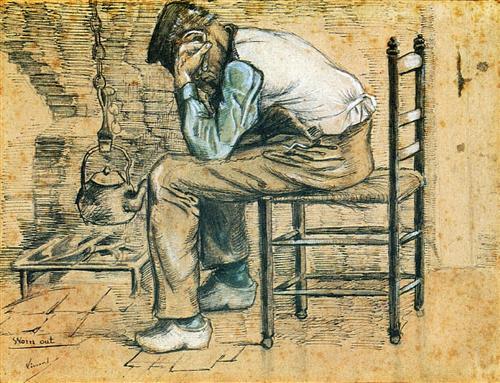Vincent Willem van Gogh (1853-1890) was one of the most conspicuous painters of the 19th century. However, he was not recognized at the time (Butterfield, 2011). His life was a tough one; fiery temper, unsuccessfulness in his careers, and hard relationships with his family were the burdens he and his milieu had to carry.
It is also widely speculated that van Gogh suffered from a mental disorder. However, it is possible that, had it been not for his difficult life, he wouldn’t have been known today as a great painter. Many of his paintings, such as his “Peasant Sitting by the Fireplace,” reflect the sorrow of the artist and the grimness of the situation he lived in.
Many scholars state that not only his unprecedented talent but also the events of his life led to his painting his masterpieces. It is believed that van Gogh was unstable even in his early childhood (Smith & Naifeh, 2011). His family, friends, and acquaintances considered him a reticent personality. As Vincent grew older, violent and unpredicted behavior started to emerge in the list of his personal traits. Failed romantic relationships and an inability to socialize were the factors that contributed to van Gogh’s mental disorder.
Many researchers highlight the importance of art in the life of the young man. It was one of his few consolations. However, his hard life and the lack of attention from the society were a lot more than the art genius could have handled. It is claimed that “his mental state was so precarious that it took only the humblest provocation to bring on the storm” (Smith & Naifeh, 2011, p.356). The most widespread belief amongst psychiatrists is that the Dutch painter suffered from manic depression, an ailment common among artistic personalities.
Besides the information from van Gogh’s biographical books, a good way to analyze his state of mind is to study his paintings and the time sequence of when they were painted from both the personal and social perspectives.
The picture under consideration is the “Peasant Sitting by the Fireplace (‘Worn Out’),” drawn in September 1881. This one is among my personal favorites; it was created during the time when the artist was fascinated by the life of simple rural workers. Van Gogh was also highly interested in figure drawing (Smith & Naifeh, 2011, p. 241, 317-321).

It is also paramount to explain the historical context in which van Gogh lived. The continuing political conflicts (e.g., Franco-Prussian War) added to the pressure that van Gogh experienced throughout his life. But, importantly, having failed in all the careers that the artist tried to pursue (namely, teaching, bookselling, and preaching) worsened van Gogh’s relationships with his family (Butterfield, 2011; Smith & Naifeh, 2011).
Also, during the time he spent as a missionary in a coal-mining community in 1879, he perceived the extremely poor conditions that the lower class lived in and sympathized with them strongly (Butterfield, 2011; Smith & Naifeh, 2011). It is apparent that the theme of “Peasant Sitting by the Fireplace” was taken from that context; the dejected peasant reflects the sorrow for the situation that so many people had to live in.
Before analyzing the drawing from a psychological viewpoint, it is important to remember that Vincent van Gogh was a renowned self-portrait artist. Many of his art admirers believe that all of his portraits reflect his inner state to some extent. The name of the picture itself is rather symbolic. The two words in the brackets are the name of the group of peasant portraits. These words play a crucial role in the understanding of this piece of art.
They point out that it is not solely the physical fatigue that makes the old man in the picture lean onto his palms, but his state of consciousness. The choice of color tones should also be paid attention to since each color represents a certain level of emotional tension on the scale from low to high (Osi & Byle, 2009). The colors are dark and gloomy, proving that the outer world and the inner perception of the person in the picture coincide.
Psychiatrists point out that manic depression is a condition that includes periods of active creativity and the lack of such; the latter is accompanied by the feeling of helplessness and desperation (Lewis, 2010). The latter state can be perceived in the drawing.
The posture of the man shows his dejection; such a pose is characteristic of a state when a person is exhausted emotionally and has lost any hope that the situation will be resolved. The other remarkable detail is the fireplace the peasant is sitting at. After looking at the painting, it is apparent that, despite the proximity, the man pays no attention to the heat, as if his mental pain overrides the physical one (van Gogh, 1881).
To conclude, Vincent van Gogh’s paintings are full of vivid positive and dark negative emotions, which often reflect the painter’s state of mind. It is questionable if he could have become such a great artist without being inflicted by the psychological illness (Smith & Naifeh, 2011).
References
Butterfield, B. (2011). The Troubled Life of Vincent Van Gogh. Web.
Lewis, B. (2010). Moving beyond Prozac, DSM, and the new psychiatry: The birth of postpsychiatry. Detroit, MI: University of Michigan Press.
Osi, G., & Byle, W. (2009). Therapy in color: The ultimate therapeutic coloring experience for adults. Salem, MA: Creative Dreams Concepts.
Smith, G., & Naifeh, S. (2011). Van Gogh. New York, NY: Random House Trade Paperbacks.
Van Gogh, V. (1881). Peasant sitting by the fireplace (worn out).